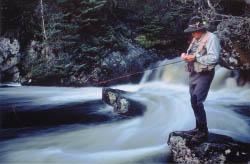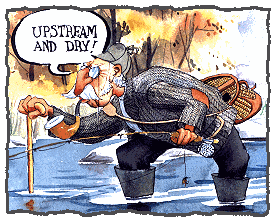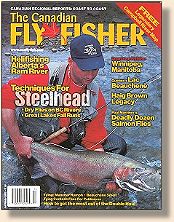The Absolute Beginner
Fishing The Dry Fly

By Piscator
For many fly fishers, the ultimate is matching the hatch with dry flies on streams
and rivers. But many beginners find dry fly fishing a bit intimidating. They shouldn't.
For, while fishing dry flies might be more demanding then swinging a streamer or wet
fly across and downstream, it's not that much more difficult - and it's certainly not as
demanding as some methods of nymph fishing. For instance, you can see the fly,
so you can always tell whether or not you have the appropriate presentation, and
there is never any doubt when a fish takes it. There are really only two things to
master: accurate presentation and positive line control once the fly is on the water,
and the basics of these are not particularly difficult.
Equipment
Rod length is a matter of personal preference, but it should have a stiff action.
Most modern graphite models fit the bill nicely. Line weight should be appropriate
to the size of the water, fish and flies. It's best to avoid ultra-light outfits (4wt and
under) until you've got a couple of seasons under your belt. Weight forward lines
will facilitate turn-over, helping you drop a bushy fly with a straight leader, especially
when you're casting into the wind. Double taper lines don't deliver as much punch,
but they'll help you deliver the fly more delicately. Selecting or building a leader with
a stiff butt and limp tippet will augment this. Some manufacturers offer tapered
leaders labeled "dry fly." These are a safe choice.
Flies and matching the hatch
When you're just starting out as a fly fly fisher, it's best not to become too preoccupied
with matching the hatch precisely. While you will undoubtedly encounter selective fish
(especially on heavily-fished waters), much of the time it's how you present the fly
which counts. Instead of carrying dozens of precise imitations of the natural insects,
you're better off using impressionistic patterns. There are a number of tried and
tested patterns which will serve you well in most situations. Just make sure you have
both upwing styles to imitate mayflies and downwing styles to imitate caddis and
stoneflies. All you have to do is choose one which approximates the size and shape
of what is hatching. While there will be times when you'll be frustrated by fastidiously
selective fish, these times wil usually be few.
The following is a selction of dry flies which should serve you
well almost anywhere in the country:
Adams 14-18
Irresistible 12-16
Wulffs 10-16
Humpy 10-16
BWO 14-20
Hair wing caddis 12-18
|
The kind of water you fish can affect selectivity. You'll find that the fish in fast, broken
water will tend to be far less picky then those in smooth water, as the former have
little time to inspect flies closely as they're swept downstream.
Fishing the Rise
Dry fly fishing is at its best when fish are actively feeding on the surface or in the
surface film. The technique is basically simple - you have to place your fly
upstream of a feeding fish and manipulate the line so that the fly will drift naturally
over the spot where the fish is rising.
There are two main things to focus on: how the line, leader, and fly land on the water;
and how you control these as the fly drifts downstream. This is what we call
"presentation." Presentation has three purposes - to avoid spooking the fish, to
ensure the optimum natural drift of the fly, and to enable positive hook set.
Fish can be spooked by the line, leader or fly hitting the water too heavily. They
can also be spooked by the line drifting over them ahead of the fly, or if the
leader and fly are bunched up in a messy coil. The key to avoiding this lies in
accurate, controlled casting, so that the line does not fall or drift over where
the fish is lying and the leader turns over cleanly to land straight.
Casting is also part of the answer to getting a natural drift - that is, an artificial
fly which floats downstream just like the natural insects are doing. Most of the
time, this means a dead drift, but sometimes, when naturals are struggling or
being wind-blown on the surface, a twitched or skated artificial is needed. Getting
a dead drift involves laying the line and leader on the water with enough slack and
the appropriate configuration so that the current does not pull on it, dragging the
fly unnaturally.
Fishing the Water
There'll be times when you'll find there are no fish rising. However, this doesn't mean
you have to abandon the dry fly, for you can "fish the water" by casting to places where
there could be a holding fish. Look for the usual hot spots: the edges of inflows to
pools; alongside logs, rocks, and undercuts in riffles and runs; and pockets in riffles.
Just imagine that you've seen a rise there and drop your fly a couple of feet above it.
You'll find that impressionistic attractor flies work particularly well in this situation.
Upstream or downstream?
 It's almost always best to use the classic upstream approach when fishing dry flies - not
so much for tradition's sake, but because this is the best way to approach fish unseen
and to get a natural drift of the fly. However, it's more demanding in terms of line
control than swinging a wet fly downstream, for you have to take in the slack line
as it drifts back to you. If you don't, you'll lost contact with the fly, which makes
setting the hook almost impossible. What you have to do is take in the slack with the
line hand, at just the right rate to stay in contact with the fly without dragging it.
It's almost always best to use the classic upstream approach when fishing dry flies - not
so much for tradition's sake, but because this is the best way to approach fish unseen
and to get a natural drift of the fly. However, it's more demanding in terms of line
control than swinging a wet fly downstream, for you have to take in the slack line
as it drifts back to you. If you don't, you'll lost contact with the fly, which makes
setting the hook almost impossible. What you have to do is take in the slack with the
line hand, at just the right rate to stay in contact with the fly without dragging it.
An angled cast across and upstream is usually better than a direct upstream cast, as
this makes it easier to avoid putting the line over the fish and minimises the need to
take in slack line.

At times you'll find fish rising in places where you have to cast downstream. In this
case, make a slack cast so that the fly drifts naturally as the current straightens out
the slack.
This might seem complicated, but after a few self-analytical session on the water,
you'll soon get the hang of it.
~ Piscator
|







